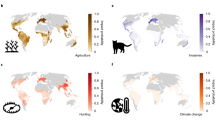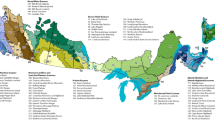Abstract
We applied the IUCN Red List method for threat assessment to the amphibians and reptiles of El Salvador, the smallest Central American country. Seventy-six out of 130 species were found to be threatened or endangered at the national level. In general, most threatened taxa were aquatic organisms in lowland habitats or cloud-forest specialists in highland areas. The IUCN method was biased by collecting effort and was unable to classify 25 species that were categorized as ȁ8data deficientȁ9. We used the number and distribution of threatened species and a complementarity analysis to identify departments in El Salvador that require higher priority for conservation action. We applied a method for evaluating inventory completeness to our data set, and used species from reasonably well-surveyed taxonomic groups (Anura and Sauria) to carryout the complementarity analysis. The anurans (frogs) and saurians (lizards) had been inventoried relatively completely in 10 of 14 departments. The department with the most threatened species (35 of 76 threatened amphibians and reptiles) is Santa Ana, where many threatened species occur in pine-oak and cloud forest in Montecristo National Park.
Similar content being viewed by others
References
M. Barinaga (1990) ArticleTitleWhere have all the froggies gone? Science 247 1033–1034
A.R. Blaustein D.G. Hokit R.K. Oȁ9Hara R.A. Holt (1994) ArticleTitlePathogenic fungus contributes to amphibian losses in the Pacific Northwest Biol. Conserv. 67 251–254 Occurrence Handle10.1016/0006-3207(94)90616-5
J.H. Brown (1984) ArticleTitleOn the relationship between species abundance and distribution of species Am. Nat. 124 255–279 Occurrence Handle10.1086/284267
J.H. Brown D.W. Mehlman G.C. Stevens (1995) ArticleTitleSpatial variation in abundance Ecology 76 2028–2043
M.A. Burgman S. Ferson H.R. Akçakaya (1993) Risk Assessment in Conservation Biology Chapman & Hall New York
J.A. Campbell (1999) Distribution patterns of amphibians in Middle America W.E. Duellman (Eds) Patterns of Distribution of Amphibians: A Global Perspective The Johns Hopkins University Press Baltimore, Maryland 111–210
H.E. Daugherty (1972) ArticleTitleThe impact of man on the zoogeography of El Salvador Biol. Conserv. 4 273–278 Occurrence Handle10.1016/0006-3207(72)90125-5
W.E. Duellman (1999) Global distribution of amphibians: patterns, conservation, and future challenges W.E. Duellman (Eds) Patterns of Distribution of Amphibians: A Global Perspective The Johns Hopkins University Press Baltimore, Maryland 1–30
W.E. Duellman (2001) The Hylid Frogs of Middle America2nd ed Society for the Study of Amphibians and Reptiles Ithaca, New york
U. Gärdenfors J.P. Rodríguez C. Hilton-Taylor C. Hyslop G. Mace S. Molur S. Poss (1999) ArticleTitleDraft guidelines for the application of IUCN Red List criteria at national and regional levels Species 31–32 58–70
M.E. Godown A.T. Peterson (2000) ArticleTitlePreliminary distributional analysis of US endangered bird species Biodiv. Conserv. 9 1313–1322 Occurrence Handle10.1023/A:1008924322405
H. Gómez de Silva R.A. Medellín (2001) ArticleTitleEvaluating completeness of species lists for conservation and macroecology: a case study of Mexican land birds Conserv. Biol. 15 1384–1395 Occurrence Handle10.1046/j.1523-1739.2001.00177.x
D.M. Green (2003) ArticleTitleThe ecology of extinction: population fluctuation and decline in amphibians Biol. Conserv. 111 331–343 Occurrence Handle10.1016/S0006-3207(02)00302-6
Greenbaum E. 2004. A new species of Bolitoglossa (Amphibia: Caudata: Plethodontidae) from montane forests in Guatemala and El Salvador. J. Herpetol. 38: 411–421.
E.E. Holmes (2001) ArticleTitleEstimating risks in declining populations with poor data Proc. Nat. Acad. Sci. USA 98 5072–5077 Occurrence Handle10.1073/pnas.081055898 Occurrence Handle11309483
InstitutionalAuthorNameIUCN (2001) IUCN Red List Categories, Version 3.1. Prepared by the IUCN Species Survival Commission IUCN Gland, Switzerland
IUCN 2002. 2002 IUCN Red List of threatened species. < http://www.redlist.org. Downloaded 6 May 2003.
IUCN Conservation International & Nature Serve 2004. Global Amphibian Assessment. www.globalamphibians.org Accessed 11 December 2004.
N. Jorgeda Silva SuffixJr. J.W. Sites SuffixJr. (1995) ArticleTitlePatterns of diversity of neotropical squamate reptile species with emphasis on the Brazilian Amazon and the conservation potential of indigenous reserves Conserv. Biol. 9 873–901 Occurrence Handle10.1046/j.1523-1739.1995.09040873.x
J.B. Kirkpatrick (1983) ArticleTitleAn iterative method for establishing priorities for the selection of nature reserves: an example from Tasmania Biol. Conserv. 25 127–134 Occurrence Handle10.1016/0006-3207(83)90056-3
G. Köhler (2000) Reptilien und Amphibien Mittelamerikas. Band 1: Krokodile. Schildkröten, Echsen Herpeton Verlag Offenbach, Germany
G. Köhler (2001) Reptilien und Amphibien Mittelamerikas. Band 2: Schlangen, Doppelschleichen Herpeton Verlag Offenbach, Germany
G. Köhler (2003) Reptiles of Central America Herpeton Verlag Offenbach, Germany
Köhler G., Veselý M. and Greenbaum E. The Amphibians and Reptiles of El Salvador. Krieger Publishing Company, Melbourne, Florida, in press.
O. Komar (2002) ArticleTitlePriority conservation areas for birds in El Salvador Anim. Conserv. 5 173–183 Occurrence Handle10.1017/S1367943002002238
W.F. Laurance K.R. McDonald R. Speare (1996) ArticleTitleEpidemic disease and the catastrophic decline of Australian rain forest frogs Conserv. Biol. 10 406–413 Occurrence Handle10.1046/j.1523-1739.1996.10020406.x
R.O. Lawton U.S. Nair R.A. Pielke SuffixSr. R.M. Welch (2001) ArticleTitleClimatic impact of tropical lowland deforestation on nearby montane cloud forests Science 294 584–587 Occurrence Handle11641496
D. Lunney A. Curtin D. Ayers H.G. Cogger C.R. Dickman (1996) ArticleTitleAn ecological approach to identifying the endangered fauna of New South Wales Pac. Conserv. Biol. 2 212–231
D.M. Marsh (2001) ArticleTitleFluctuations in amphibian populations: a meta-analysis Biol. Conserv. 101 327–335 Occurrence Handle10.1016/S0006-3207(01)00076-3
D.M. Marsh P.C. Trenham (2001) ArticleTitleMetapopulation dynamics and amphibian conservation Conserv. Biol. 15 40–49 Occurrence Handle10.1046/j.1523-1739.2001.00129.x
I. Martínez-Solano J. Bosch M. García-París (2003) ArticleTitleDemographic trends and community stability in a montane amphibian assemblage Conserv. Biol. 17 238–244 Occurrence Handle10.1046/j.1523-1739.2003.01096.x
J.R. McCranie L.D. Wilson (1993) ArticleTitleA review of the Bolitoglossa dunni group (Amphibia: Caudata) from Honduras with the description of three new species Herpetologica 49 1–15
J.R. McCranie L.D. Wilson (2002) The Amphibians of Honduras. Society for the Study of Amphibians and Reptiles Ithaca New york
InstitutionalAuthorNameMinisterio de Agricultura y Ganadería. (1998) Listado Oficial de Las Especies de Fauna Vertebrada Amenazada y en Peligro de Extinción en El Salvador Dirección General de Recursos Naturales y Renovables, Servicio de Parques Nacionales y Vida Silvestre SoyapangoSan SalvadorEl Salvador
InstitutionalAuthorNameMinisterio de Agricultura y Ganadería. (2004) ArticleTitleListado oficial de especies de fauna silvestre amenazada o en peligro de extinción en El Salvador Diario Oficial (San SalvadorEl Salvador) 363 IssueID78 5–27
R.A. Mittermeier (1970) ArticleTitleTurtles in Central American markets Int. Turtle Tortoise Soc. J. 4 20–26
C. Morrison J.-M. Hero (2003) ArticleTitleGeographic variation in life-history characteristics of amphibians: a review J. Anim. Ecol. 72 270–279 Occurrence Handle10.1046/j.1365-2656.2003.00696.x
C. Parmesan G. Yohe (2003) ArticleTitleA globally coherent fingerprint of climate change impacts across natural systems Nature 421 37–42 Occurrence Handle10.1038/nature01286 Occurrence Handle12511946
J.H.K. Pechmann D.E. Scott R.D. Semlitsch J.P. Caldwell L.J. Vitt J.W. Gibbons (1991) ArticleTitleDeclining amphibian populations: the problem of separating human impacts from natural fluctuations Science 253 892–895
J.R. Prendergast R.M. Quinn J.H. Lawton B.C. Eversham D.W. Gibbons (1993) ArticleTitleRare species, the coincidence of diversity hotspots and conservation strategies Nature 365 335–337 Occurrence Handle10.1038/365335a0
C.J. Raxworthy R.A. Nussbaum (2000) ArticleTitleExtinction and extinction vulnerability of amphibians and reptiles in Madagascar Amphibian Reptile Conserv. 2 15–23
J.V. Remsen SuffixJr. (1994) ArticleTitleUse and misuse of bird lists in community ecology and conservation Auk 111 225–227
T.L. Root J.T. Price K.R. Hall S.H. Schneider C. Rosenzweig J.A. Pounds (2003) ArticleTitleFingerprints of global warming on wild animals and plants Nature 421 57–60 Occurrence Handle10.1038/nature01333 Occurrence Handle12511952
M.J. Samways (2003) ArticleTitleMarginality and national Red Listing of species Biodiv. Conserv. 12 2523–2525 Occurrence Handle10.1023/A:1025840000200
T. Stephan K. Ulbrich W.-R. Grosse F. Meyer (2001) ArticleTitleModelling the extinction risk of isolated populations of natterjack toad Bufo calamita Web Ecol. 2 47–56
A.S. van Jaarsveld S. Freitag S.L. Chown C. Muller S. Koch H. Hull et al. (1998) ArticleTitleBiodiversity assessment and conservation strategies Science 279 2106–2108 Occurrence Handle10.1126/science.279.5359.2106 Occurrence Handle9516111
P. Williams D. Gibbons C. Margules A. Rebelo C. Humphries R. Pressey (1996) ArticleTitleA comparison of richness hotspots, rarity hotspots, and complementary areas for conserving diversity of British birds Conserv. Biol. 10 155–174 Occurrence Handle10.1046/j.1523-1739.1996.10010155.x
E.O. Wilson (1992) The Diversity of Life Harvard University Press Cambridge, Massachusetts
L.D. Wilson J.R. McCranie (2003) ArticleTitleThe conservation status of the herpetofauna of Honduras Amphibian Reptile Conserv. 3 6–33
Author information
Authors and Affiliations
Corresponding author
Rights and permissions
About this article
Cite this article
Greenbaum, E., Komar, O. Threat Assessment and Conservation Prioritization of the Herpetofauna of El Salvador. Biodivers Conserv 14, 2377–2395 (2005). https://doi.org/10.1007/s10531-004-1670-3
Received:
Accepted:
Issue Date:
DOI: https://doi.org/10.1007/s10531-004-1670-3




